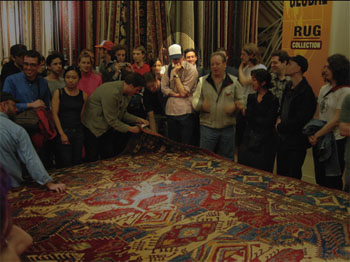
While looking into performance artists I noticed an association with flash mobs and starting reading about them. Surprisingly I found that the “flash mob” concept was “invented” buy an editor for Harper’s Magazine named Bill Wasik; In his own description this was meant to be a social science experiment. However, after reading this week’s reading by Lucy Lippard and Wasik’s own description of the event It seems to fit in the cannon of performance and conceptual art.

The first flash mobs were organized by Wasik in 2003 via email chains. It seems that the basic concept was a criticism of a hypocritical conformist culture.
“I was pointing out that hipsters, our supposed cultural avant-garde, are in fact a transcontinental society of cultural receptors, straining to perceive which shifts to follow.”
Wasik makes clear that much of the project or “experiment” was meant to stoke the vanity of his participants by creating a sense that their special knowledge and conformity gave them a form of power over others who were out of the loop. Often it seems these displays of power were deployed in a self-ridiculing way (Wasik seems to have some contempt for the “hipsters” whom he considers his participants), such as the first successful flash mob which took place at the Herald Sq. Macy’s. In this case a large group following instructions quickly grew around a specific rug in the Macy’s show room and explained to staff and passersby that they were a collective from Long Island looking for a “love rug” and had to make the decision as a group. Wasik says that a major inspiration for this was Stanley Milligram’s body of work. Wasik writes, “The Milgramite tradition in art would be defined, I think, by the following premise: that man, whom we now know to respond predictably to social forces, is therefore himself the ultimate artistic medium”. This reminded me a lot of Lippard’s example of the artist who locked their gallery attendees in an empty room until they attempted to break out or the artist who mailed a list of orders to a dictator.
Wasik was able to keep his involvement in these flash mobs a mystery for many years until he sought out a corporatized adoption of the flash mob used as a promotion for a branded concert series. later, in a 2006 article for Harper’s Wasik then describes the process of developing the flash mob, its development of a international following, the backlash, and finally the corporatization as a piece in itself, calling each one a step. Ultimately Wasik considerers the moral implications of having introduced yet another instantiation of mindless youth conformity but then defends his work with the words of Stanley Milligram:
“Milgram relates the story of a young man who had been through the study in 1964 and six years later sent a letter to Milgram telling him that, as a result, he was seeking CO status to avoid fighting in Vietnam.
‘He was going to be sent by our government to Southeast Asia to drop napalm on innocent villagers, to despoil the land, to massacre. He informs me, as many others have done, that the experiment has deepened his understanding of the moral problems of submitting to malevolent authority. He has learned something. He takes a stand. He becomes a conscientious objector. Has he been victimized by the experiment, or has he been liberated by it'”

Works consulted:
https://en.wikipedia.org/wiki/Stanley_Milgram
https://en.wikipedia.org/wiki/Flash_mob
Lucy Lippard “Six Years: The Dematerialization of the art object from 1966 to 1972”